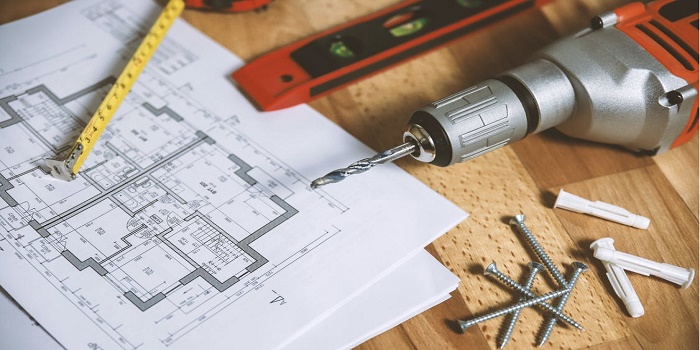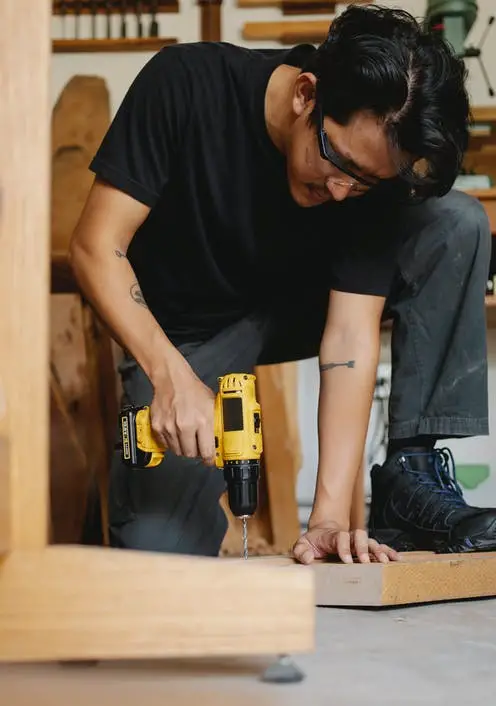
Wooden furniture, trims, doors, and windows are so long-lasting that you can easily repair and reuse them even after they get some cracks, gaps, and holes.
The key here is knowing how to fill these holes correctly so you can redrill the wood.
Fortunately, there are a number of products and ways by which you can repair a hole in the wood for screwing – to make it reusable.
Using wood fillers (such as FamoWood or Elmer’s) is one of the easiest methods to make the wood so hard that you can permanently cover the old holes, cracks, and gaps to redrill or screw them into without damaging the wood itself.
Interested in knowing more about how to use these wood fillers properly, what fillers are best, and what other alternative methods you can use to fill the holes or gaps? Let’s dive in right below…
3 Different Ways to Fill a Hole in Wood
When it comes to filling the holes in wood (whether small or large), I generally use three methods.
As I said before, the first one is using wood filler. The second is by using wood plugs, and the third is by using wood glue.
Below is a step-by-step process you must follow when using these different methods.
Method 1. Wood Filler
Wood filler is generally used for filling up small holes (like the ones formed by nails, screws, wood-boring insects, etc.).
Online you can find a variety of different wood fillers. Some of them are:
| Wood filler | Usage | Drying time |
|---|---|---|
| Vinyl | Indoor floor and furniture | 15-24 hours |
| Gypsum | Both indoors and outdoors | Around 1 hour |
| Cellulose | Outdoor furniture and flooring | 30-50 minutes |
| Epoxy filler | Outdoor furniture, flooring, deck, etc | 20 minutes to a few hours |
Although all will do the same job of filling the wood, not all of them can be redrilled or screwed into.
So, you will need to choose the one that can be predrilled.
Step 1 – Choose the wood filler
Weather-resistant epoxy filler is the best option when filling wood holes to redrill because it’s moisture-proof, dries quickly, and will not leave any cracks after drying.
Applying it correctly will make the surface ready to drill or nail even when the wood is located outdoors (where extreme weather conditions can be a problem).
Step 2 – Prep
When using wood filler for repair, you will need to clean and prepare the surface.
This means removing flaking paint chips around the hole using a scraper tool or sandpaper.
Next, dampen the cloth in water and clean the surface to remove any dust.
Step 3 – Fill the hole
With your preferred nail hole filler, overfill the hole.
As the filler dries up, it will most likely shrink, so overfilling the gap is recommended.
Please wait a while to dry the filler, then spread it evenly on the hole with a putty knife.
You can use your finger to press the filler inside the hole to level it up if you want.
Step 4 – Wait and smooth the area
After the hole is covered completely, wait an hour or two to get the filler dried.
Depending on the product you have used, it can take anywhere from 1 hour to 8 hours to get the filler completely dry.
Once the filler is dried, smoothen the area using fine-grit sandpaper.
Sand the surface lightly until you see the filler is got leveled up with the surface.
If you notice there is still some gap, repeat the process once again with a little bit of wood filler once again.
After the hole is filled and the filler is dried, you can now redrill the piece of wood furniture or door frame.
Method 2- Wood Plugs
Wood plugs are small circular pieces of wood that can be easily made or can be bought from online shops.
A wood plug cutter is often used for DIY making these pegs at home.
And the good thing is you can prepare them according to the size you need depending on the size and shape of the gap (crack or screw gun hole) you want to fill.
In general, wood plugs are used to fill larger holes that are long and straight deep down the wood.
To insert wooden plugs inside the wood, you can follow these simple steps…
- Pick a wood plug that will fit well inside the hole
- Apply some wood glue on the sides (or inside) of the hole
- Insert the wood plug slowly into the wooden hole
- If required, adjust the plug using a hammer; make sure you do not hit it hard
- Allow some time to dry the glue, and then using a saw, trim off the extra wood plug
- Finally, with a piece of sandpaper, sand the area to level up the surface and give a nice finished look.
Method 3- Sawdust & Glue
One of the fastest and cheapest ways to fill the screw holes in wood is by using sawdust or wooden scrap.
If you are in a hurry and don’t have commercial wood fillers or plugs available, the homemade wood filler can be quickly made using sawdust and glue.
Remember that the process can be messy if you have not done it before.
So, start by wearing gloves and a face mask for protection.
Then follow these easy steps…
- Make some sawdust using sandpaper or an electric sander. Or, if you already have sawdust saved from your previous project – use that.
- Filter out bigger particles (dust and scraps) from the sawdust you collected
- Add some wood glue to the sawdust and mix the two materials to make a thick paste-like substance.
- Add some more glue if required, keeping in mind that you do not turn it into a runny mixture.
- After achieving the right consistency, apply the sawdust filler paste to the cracks and holes with a putty knife.
- Level the mixture, remove the excess and allow it to dry for 1-2 hours.
- After the surface is dried, sand it gently using fine-grit sandpaper. And clean the area with a tack cloth.
And that’s it!
Your surface is now ready for redrilling, screwing, or painting over.
Keep in mind that the sawdust and glue mixture gets hardened very fast.
So, you will need to use the prepared batch fast to avoid getting it wasted.
And since the remained mixture that has hardened is not workable, it’s good to dispose of it safely.
Also, make sure that you clean the putty knife fast using warm water, or it will be hard to remove the mixture later once it gets hardened on it.
What to use to fill large holes in rotted wood?
To patch a large-sized hole in rotten exterior wood, you can either use waterproof wood putty, two-part epoxy products, sawdust, or even some old wax candles.
Not only will it make the repaired wood drillable/screwable but also it will protect the wood from moisture, rainwater and snow outdoors.

How to Redrill the Wood after Repairing and Filling Holes?
Once you have filled the hole successfully, it’s essential to know how you can redrill into the wood safely to make clean holes.
Screwing in or drilling into the freshly filled area can be risky.
And if you do not follow the process patiently, you can damage the wood piece forever.
Follow these bits of advice so that you do not end up damaging your wood…
- When filling holes for redrilling, consider adding some matchsticks or toothpicks. This will increase the strength of the wood area you just filled.
- When using wood plugs for screwing or redrilling the area, consider making the pilot hole bit bigger. This will make it easier to smooth the area better.
- When drilling a hole, first mark the position with a pencil.
- Then use a hand or power drill, and do not make the hole too deep. Also, make sure you drill the hole at a right angle.
- To avoid any damage and quickly fix the new screw, consider using a screw with a wider diameter than the previous one after you have redrilled it.
- If you’re screwing into a hardwood (such as maple or walnut), consider using a soap or wax candle to lubricate the threads, which will drive the screw into the wood much more effortlessly.
Final Thoughts
Filling the screw holes, cracks, or large-sized gaps in the wood for reuse is not very easy.
You can increase the risk of damaging the wood, especially if you want to crew into or redrill the specific area after the repair.
But if you follow the above tips and steps, you can successfully repair rotten wood without needing special skills.
Choose your preferred method from above and ensure you follow the steps right so that you do not damage the wood hole and make the wood unusable.

Hi, I am Mark Garner a professional carpenter, woodworker, and DIY painter. I live in the small city of Peoria, Arizona as a semi-retired woodworker. I have started this blog with a simple motive to help you with my wood experience in this sector. If you like to know more about what I love doing and how it all got started, you can check more about me here.




